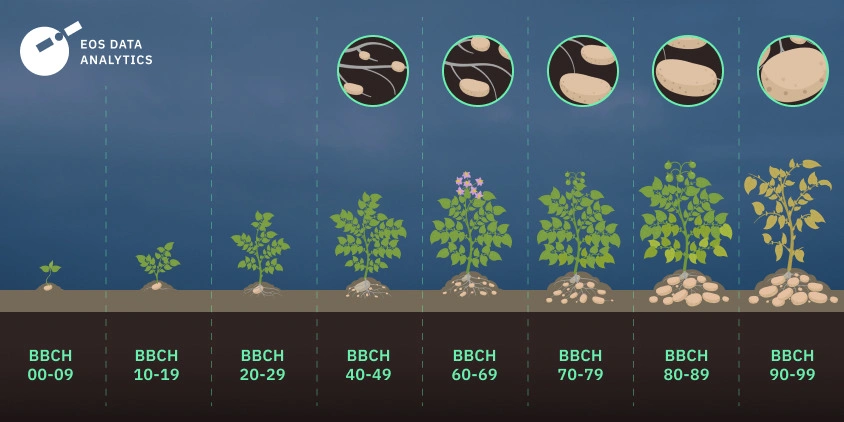
The recommendations provided in this article serve as general guidelines. Particular cultivation requirements may vary based on the unique conditions of each field and the selected hybrids.
Potato Growth Stages: Crop Management Across Life Cycle
Potatoes go through different stages of growth, each with distinct requirements. The BBCH scale provides a detailed roadmap of these potato growth stages, showing windows of opportunity and vulnerability in the plant's development. Understanding these biological milestones isn't just academic; it is practical for potato growers who aim to maximize their crop potential. For instance, knowing when tuber initiation stage begins allows you to fine-tune nutrient application for optimal yield. Recognizing the onset of senescence helps time your harvest for peak quality. With precision agriculture platforms now offering near-real-time monitoring, forecasts, and expert recommendations, agriculture players can align their management decisions with the potato stages throughout the whole growing season.
BBCH-Scale For Potato Growth Stages
Since growing potatoes from seed tubers rather than true potato seed is the standard for commercial production, we focus on the germination and early leaf stages of growth in this context. According to BBCH-scale, the potato leaf is considered unfolded when it’s larger than 1.6 inches (4 cm), and the basal side shoot is considered visible when it’s longer than 2 inches (5 cm).
Stages of potato plant growth according to BBCH-scale
BBCH 00-09: Sprouting/Germination
The sprouting/germination stage of a potato plant’s growth, which occurs mainly underground, is the plant’s first push toward sunlight. Eyes on the seed potato develop into sprouts, drawing nutrients from the mother tuber to fuel their growth. In 2–4 weeks, these potato sprouts eventually breach the soil surface, unfurling into stems and leaves. This potato plant’s growth stage sets the foundation for its future development success.
Soil Preparation And Planting
Potatoes thrive in loose, well-aerated soils that allow for rapid root penetration and tuber growth. Light and sandy loam soils are ideal, as they provide excellent drainage while retaining adequate moisture. Deep tillage creates a suitable environment for potato growth, with the depth varying based on soil composition.
The optimal potato planting depth is typically 2.4–3.1 inches (6–8 cm), measured from the top of the seed tuber to the soil surface. You can increase the depth to 3.9 inches (10 cm) on lighter sandy soils. Planting too shallow may cause the tubers to turn green, which renders them unmarketable. Proper spacing between seed tubers in a row ranges from 6 to 14 inches (15 to 35 cm), with 8 to 12 inches (20 to 30 cm) being the most common. The higher the soil fertility, the larger the spacing.
Potato Temperature And Water Requirements
The sprouting potato growth stage, lasting 25–40 days, is heavily influenced by soil temperature. Near-freezing temperatures will inhibit sprouting. To protect plants (at least 6–8 inches (15–20 cm) in height) from late frost during the early stage of growing potatoes, farmers often cover them with hills of soil or organic matter. Walls made of bricks or wire mesh help support these hills and prevent erosion in windy areas.
During the germination stage, potatoes are particularly vulnerable to overwatering, which can harm the developing sprouts. The average weekly water consumption ranges from 0.14 to 0.84 inches (3.5 to 21 mm), depending on soil and weather conditions.
EOSDA Crop Monitoring gives access to historical weather data so that farmers understand warmth and rainfall patterns specific to their potato fields and can determine optimal planting dates. They can also use the platform to check weather forecasts and anticipate when the frost might hit or when it’s going to rain, helping them maintain ideal soil temperature and moisture levels throughout the sprouting stage of potato growth.
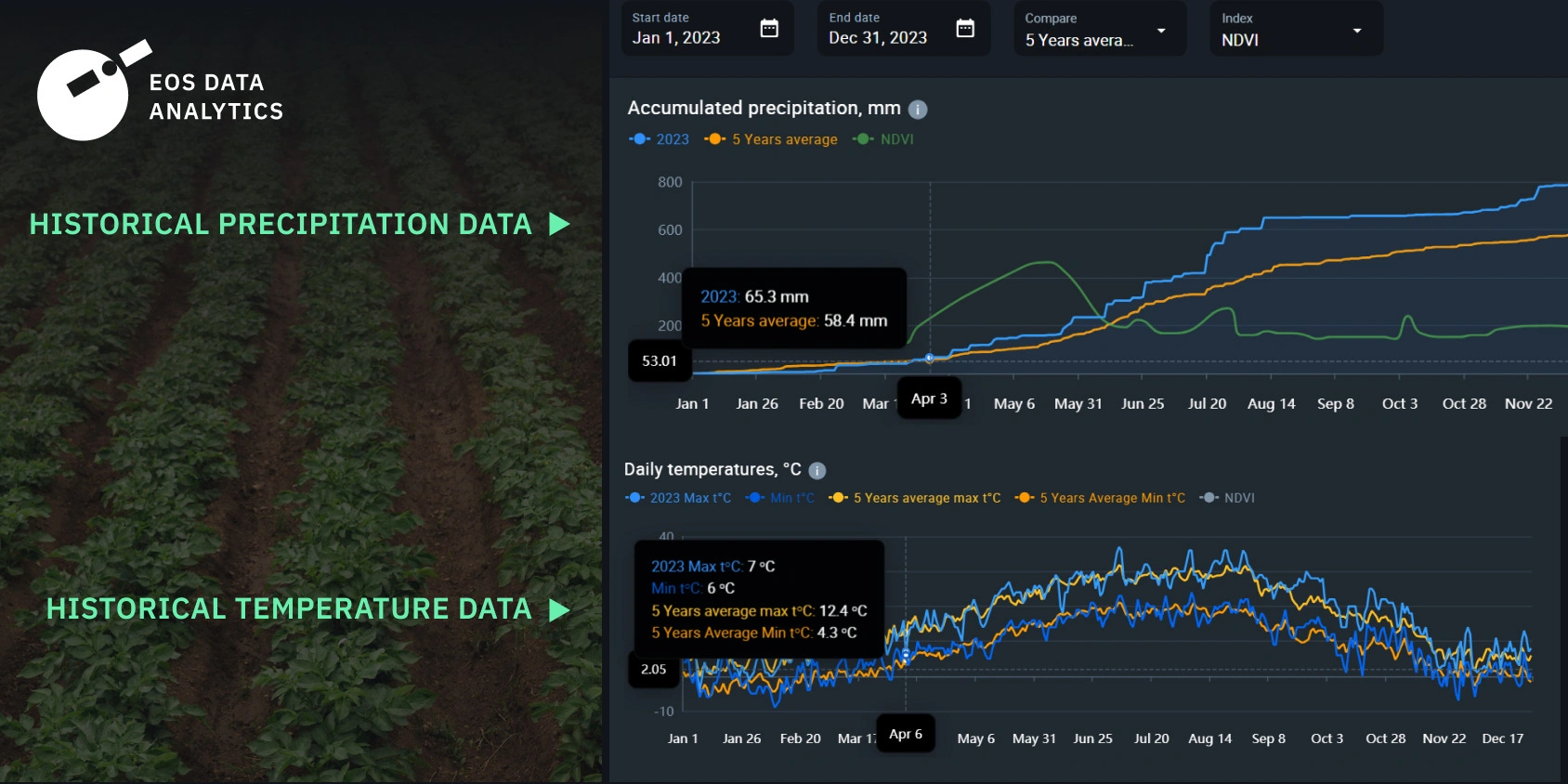
Crop Rotation
Effective crop rotation helps lower disease and pest pressure, reduce the need for fertilizers, and ultimately improve potato yields. Winter wheat is an excellent precursor crop, as it enhances soil structure, while spring legume crops like soybeans reduce the need for nitrogen. However, avoid barley due to potential Rhizoctonia issues .
With EOSDA Crop Monitoring, it’s simple to record detailed crop histories for every field. By using it, farmers may plan the best rotations for the next seasons, which bring about long-term soil fertility and sustainable potato production.
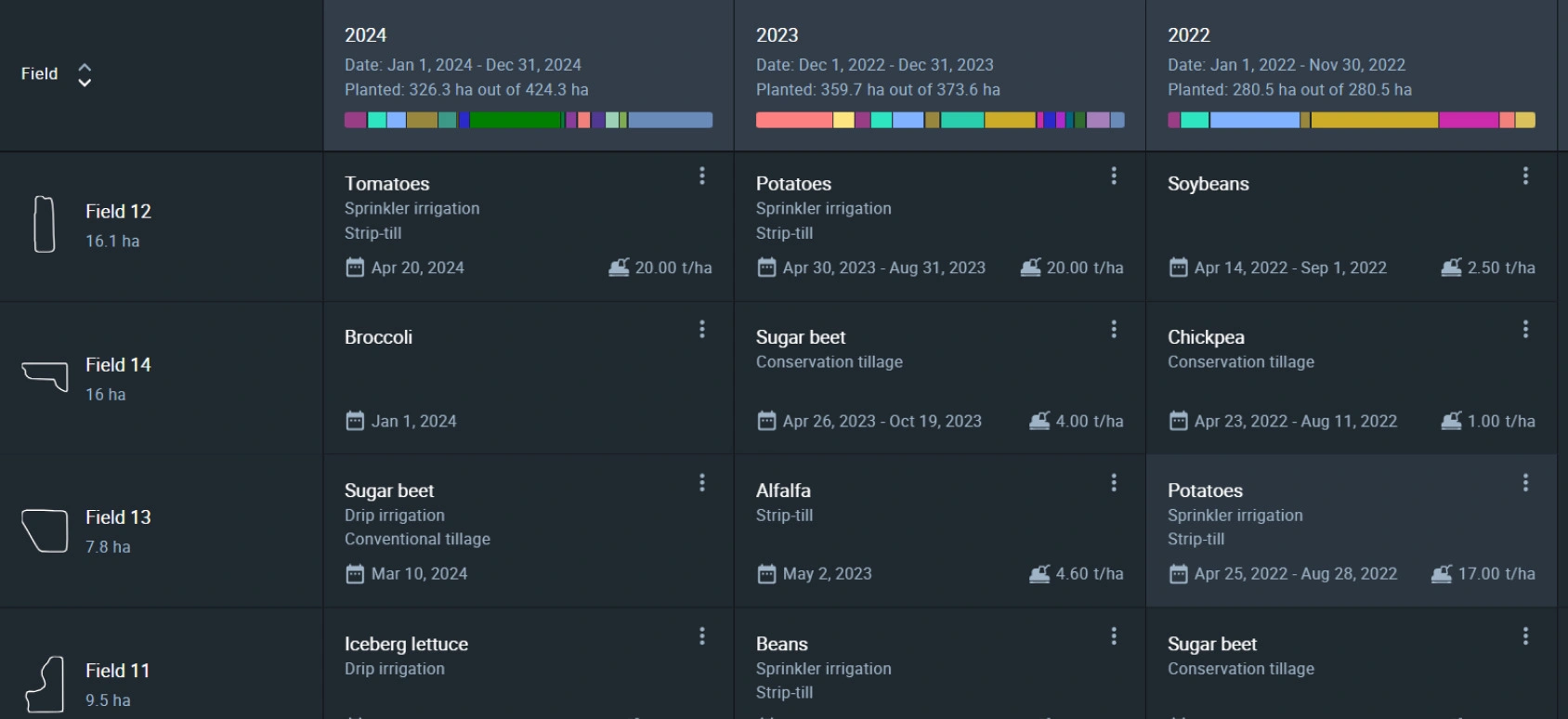
BBCH 10-19: Leaf Development
Leaf growth is one of the first markers of potato plant health. During this potato development stage, compound leaves emerge along the elongating main stem. Each sympodial branch will have fewer leaves than the main stem, creating a distinctive growth pattern.
Increased Irrigation
As the potato plants emerge, maintaining consistent soil moisture becomes essential for optimal growth and future tuber quality. Commercial potato growers typically rely on irrigation systems to ensure their fields receive adequate water at this potato plant growing stage, as rainfall is often insufficient or unreliable.
While potatoes can tolerate short dry periods, prolonged water deficiency during this growth stage can cause reduced yields and lower-quality potatoes. Aim to keep the soil consistently moist but not waterlogged, adjusting irrigation frequency and volume based on your weather conditions and soil type (more often in sandy soils).
Active Weed Management
Since at this stage the potato plants have not yet developed a full canopy, weeds can thrive in abundant light exposure. If pre-planting tillage, crop rotation, and pre-emergence herbicide applications are insufficient or neglected, weeds may proliferate rapidly, necessitating mechanical weeding.
Regular field scouting is essential to identify areas requiring weed control so that potatoes at their leaf growing stage don’t compete unnecessarily for sunlight, water, and nutrients. Using MSAVI maps and the Scouting feature in EOSDA Crop Monitoring can help monitor vegetation levels across the potato field. Thus you can detect unusually high vegetation growth early in the season, potentially indicating weed presence, and respond fast and precisely to affected areas.
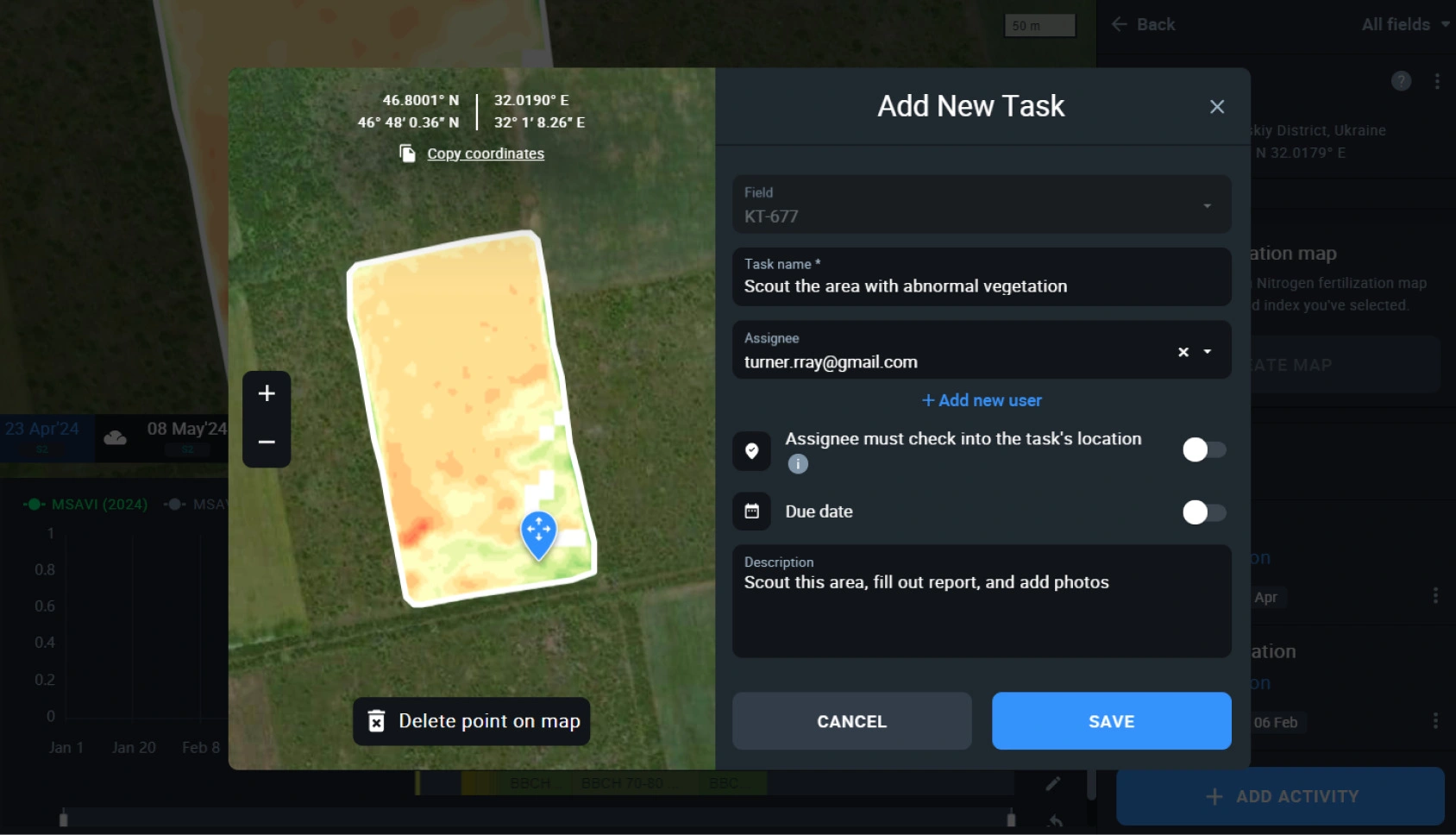
BBCH 20-29: Formation Of Basal Side Shoots Below And Above Soil Surface
During this growth stage, potatoes cultivated from tubers develop basal branches (side shoots) below and above the soil surface. Such a concurrent growth of branches is unique to tuber-grown potatoes . As the potato plant at this growth stage actively expands in all dimensions, it requires enough water to support healthy growth. And, while the plants have not yet developed a full-fledged cover, it’s necessary to control those resource-competing weeds.
With Weather forecasts in EOSDA Crop Monitoring, every farmer can have up-to-14-day precipitation outlook to plan irrigation in advance. The Spraying time scale, based on daily temperature and potato watering recommendations, helps identify the most efficient watering windows, indicated by “green hours.”
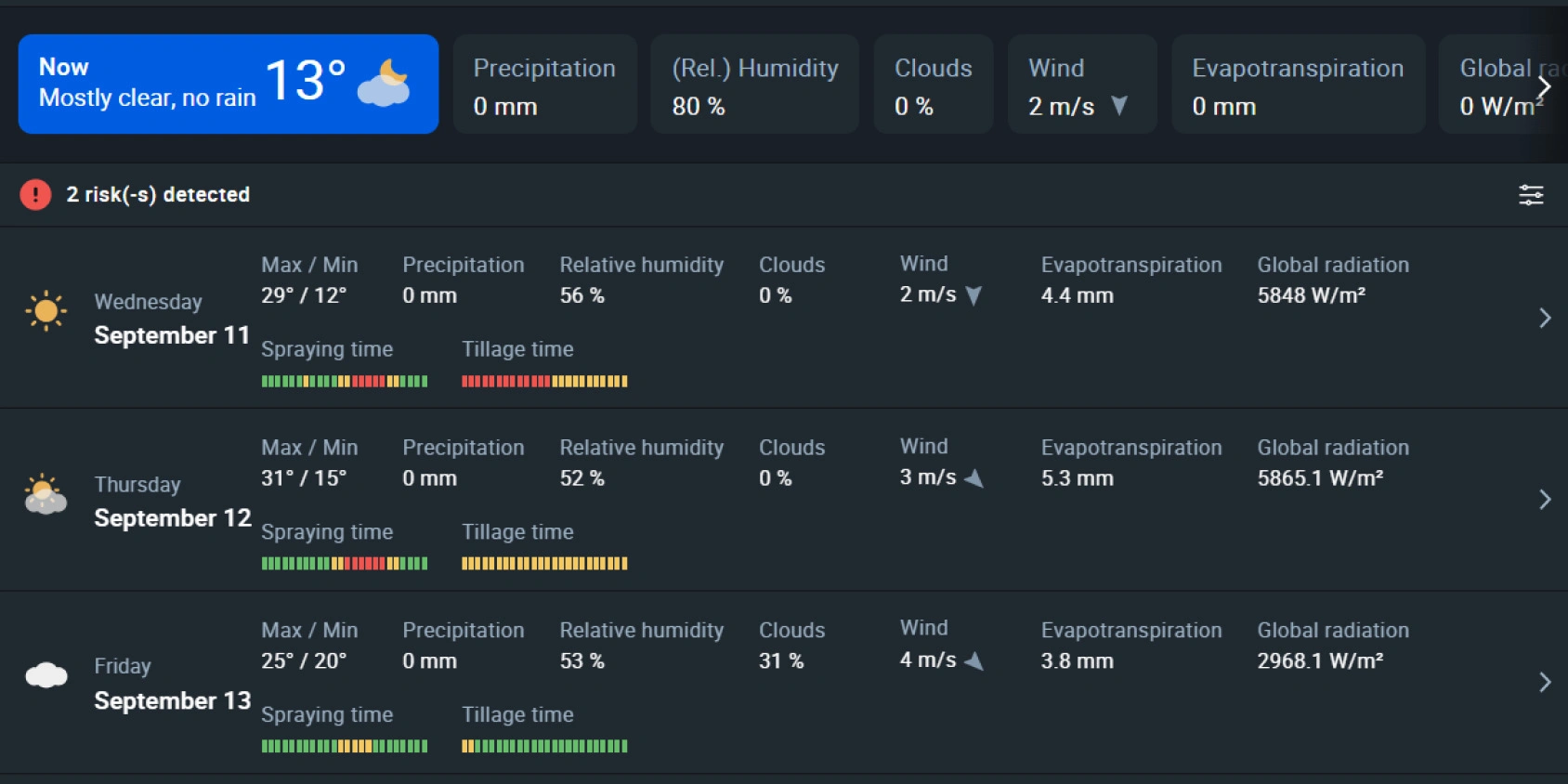
Soil moisture analytics further enhance water management efficiency during the side shoot growing potato stage. Satellite-derived soil moisture graphs offer both historical and recent data for each field, reducing the need for physical soil sampling. This way, potato growers can maintain optimal soil moisture throughout the basal shoots’ growth stage to support robust vegetative growth and future tuber formation.

BBCH 30-39: Main Stem Elongation (Crop Cover)
At this BBCH growth stage, the potato plant’s main stem elongates rapidly, and the plant starts to develop its structure and height. The unfolding and growth of leaves causes the canopy to double every week, providing the necessary photosynthesis for potato growth. Stolons (horizontal stems, which eventually give rise to tubers) also begin to form and grow from the base of the potato plant at this stage.
Irrigation Adjustments As Potato Canopy Develops
As the canopy expands weekly, potato water requirements gradually increase, typically starting at 0.5 inches (13 mm) and incrementing by approximately 0.5 inches (13 mm) each week to match the rising transpiration needs. Maintain soil moisture between 70–80% field capacity for optimal development of potatoes at this growth stage. When moisture levels drop below 65%, potatoes face water stress that impedes both foliage and root growth, which in turn reduces ground cover and compromises weed control. Conversely, overirrigation during this stage can waterlog potato root hairs, thus slowing down root branching and accelerating nitrogen leaching from the soil.
Satellite-based NDMI mapping helps better plan irrigation during the stem growth stage. These maps identify field areas requiring moisture and those adequately moistened. Potato rowers can integrate this data with precipitation forecasts to optimize their irrigation schedule throughout growth stages: watering more heavily when the dry spell is likely and conserving resources when it’s going to rain.
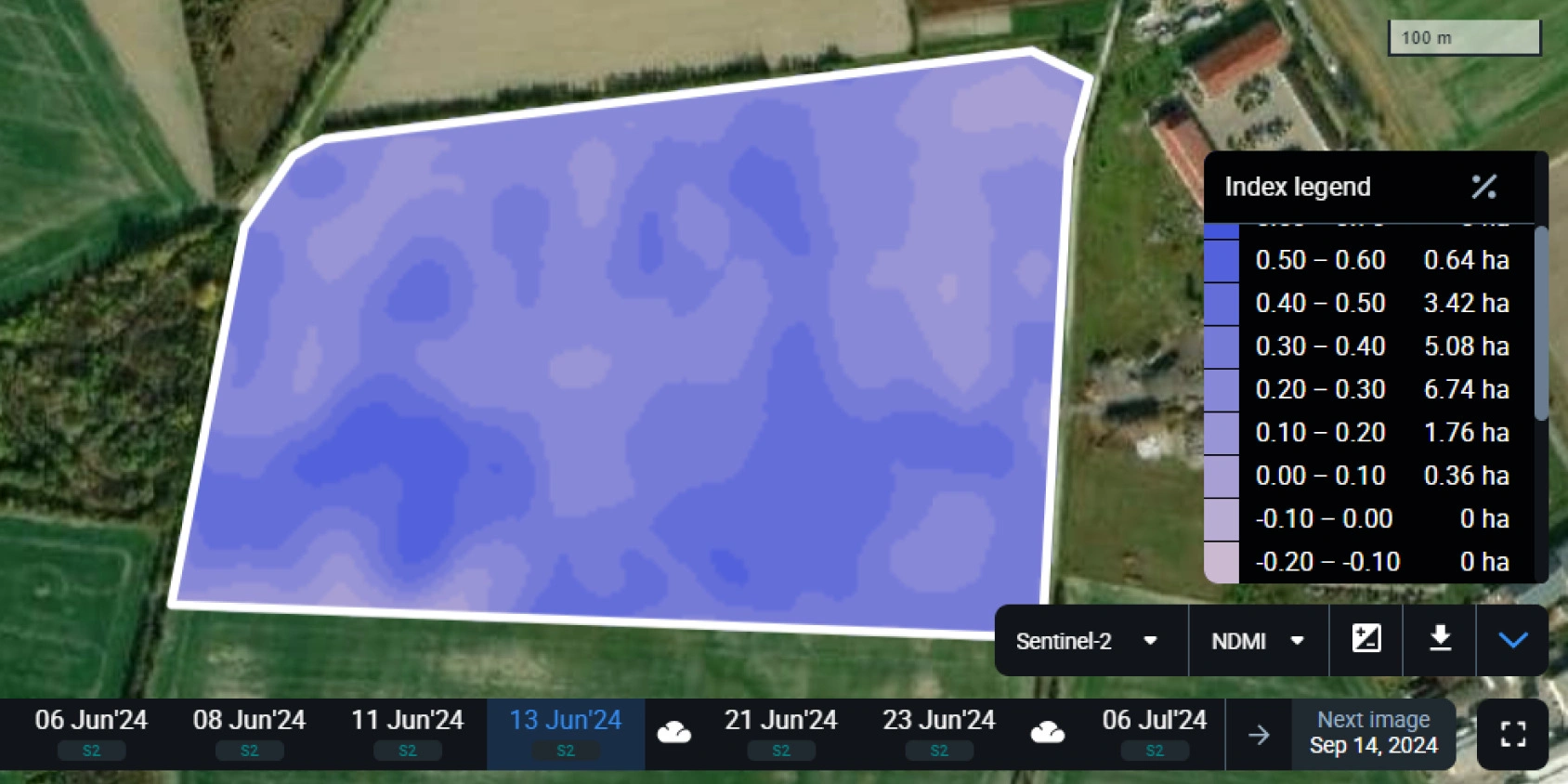
Supporting Potato Growth Through Fertilizing
Nitrogen is crucial at this potato plant stage, with its uptake being influenced by potassium and zinc levels in the soil. Adequate potassium and zinc availability before tuber induction ensures effective nitrogen utilization by the plants. This is particularly important when growing conditions of the main stem elongation stage are less than ideal (e.g. draught) .
You can identify variations in canopy development with the help of specialized index-based maps in EOSDA Crop Monitoring. Uneven potato growth across different field areas seen on the VRA Nitrogen fertilization map could be a sign of nitrogen deficiency. Easily detect potential problem areas from afar and quickly adjust your nitrogen fertilization, focusing on specific zones rather than applying a uniform treatment across the entire field. The same approach works for NPK fertilizers, which are beneficial during the main stem growth stage of the potato plant.
Modern agricultural machinery can use VRA maps exported from EOSDA Crop Monitoring. This means automated and precise fertilization with optimal nutrient delivery across your potato field.
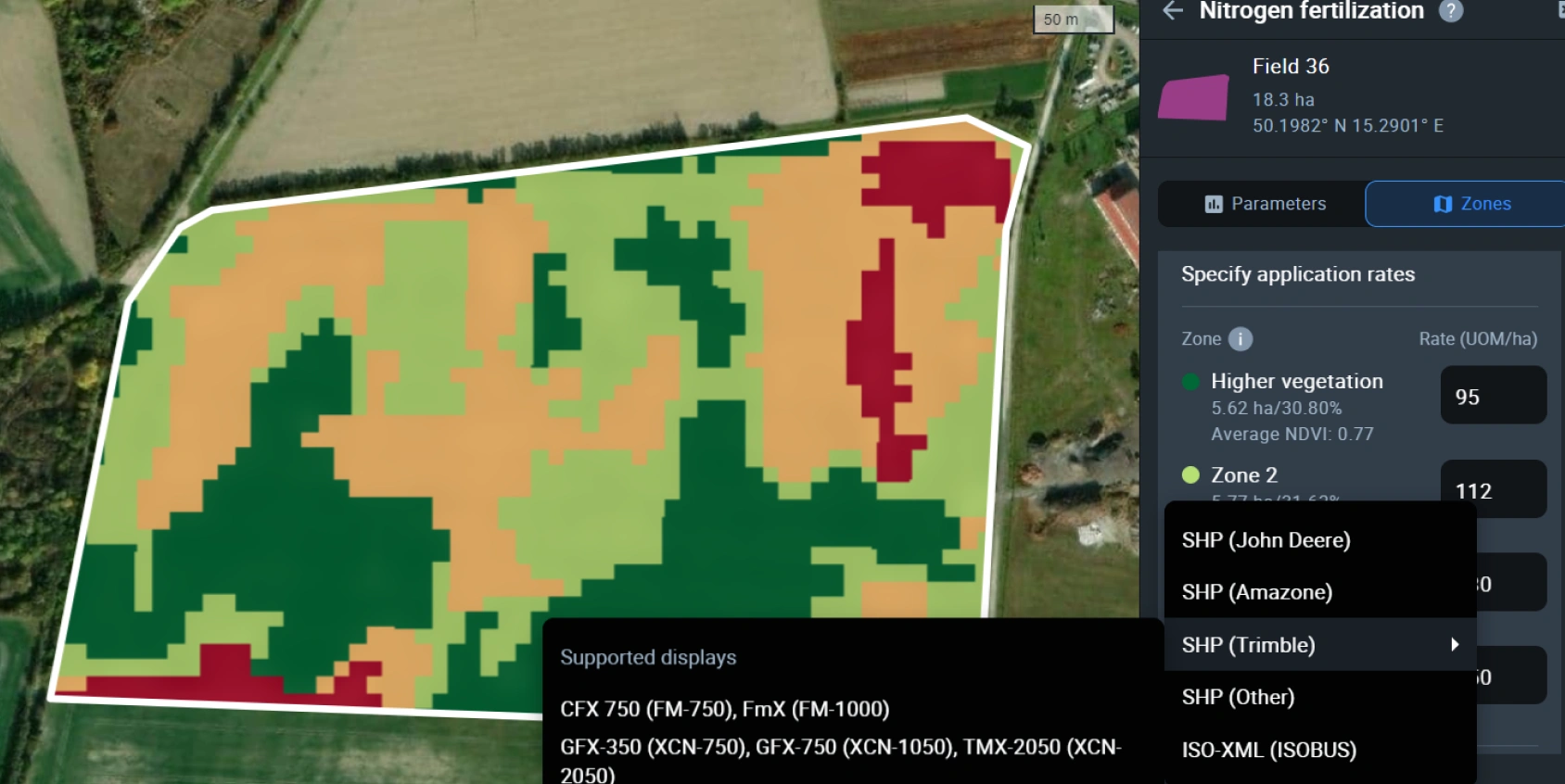
BBCH 40–49: Tuber Formation
Potato tubers emerge from underground shoots (stolons). As stolon ends swell, they initiate the set of tubers, beginning their gradual, lasting growth. Tuber formation potato stage typically begins 2–4 weeks after the crop appears above ground, but this time varies by cultivar, day length, and prevailing weather conditions.
High Water Needs And Irrigation Requirements
During the tubering growth stage, potato water requirements increase significantly, with ideal soil moisture levels between 80–90% field capacity. Potato irrigation requirements at the tuber formation stage typically range from 1.5 to 2.5 inches (35 to 63 mm) per week on sandy soils. Daily irrigation is often necessary, especially during hot weather.
Insufficient watering at this stage can cause stunted potato growth, tuber deformities, and sugar end disorder. Excess moisture, on the other hand, might delay tuber formation by encouraging overabundant foliage growth or promote fungal diseases like early and late blight.
Growers must balance irrigation carefully, adjusting it based on soil type, weather conditions, and potato variety. Excess nitrogen in the soil can prolong the potato tuber growth stage, so consider nutrient management alongside irrigation practices.
Integrated Pest Control
Heavy pest pressure coincides with the tubering growth stage of potatoes. The Colorado potato beetle is the most challenging pest threat because of its remarkable insecticide resistance. Even treated potato planting material doesn’t guarantee complete protection, so ongoing pest monitoring and management are a must.
Here are some recommendations to help you tackle Colorado potato beetles head-on:
- Defoliation threshold. Consider starting treatment when you see 10% defoliation, as early-season potato leaf loss can significantly impact yield.
- Early intervention. Apply foliar insecticides when 15–30% of eggs have hatched. This way you can target vulnerable young larvae for maximum impact and avoid significant crop damage.
- Insecticide rotation. Alternate between different classes of insecticides to prevent the resistance development in beetle populations.
Farmers must regularly inspect their fields during the tubering stage of potato life cycle to detect pest infestations early. This means inspecting potato plants twice a week for signs of defoliation and pest presence (eggs, larvae, and adult beetles checked on both upper and lower leaf surfaces). The Scouting feature in EOSDA Crop Monitoring allows you to dispatch workers to specific high-risk areas and easily keep track of pests’ presence in your fields. During these inspections, scouts can record the life stages and sizes of observed larvae and create reports with attached photos right in the field through EOSDA’s Scouting app. With this information, agronomists will know better which control measures to use.
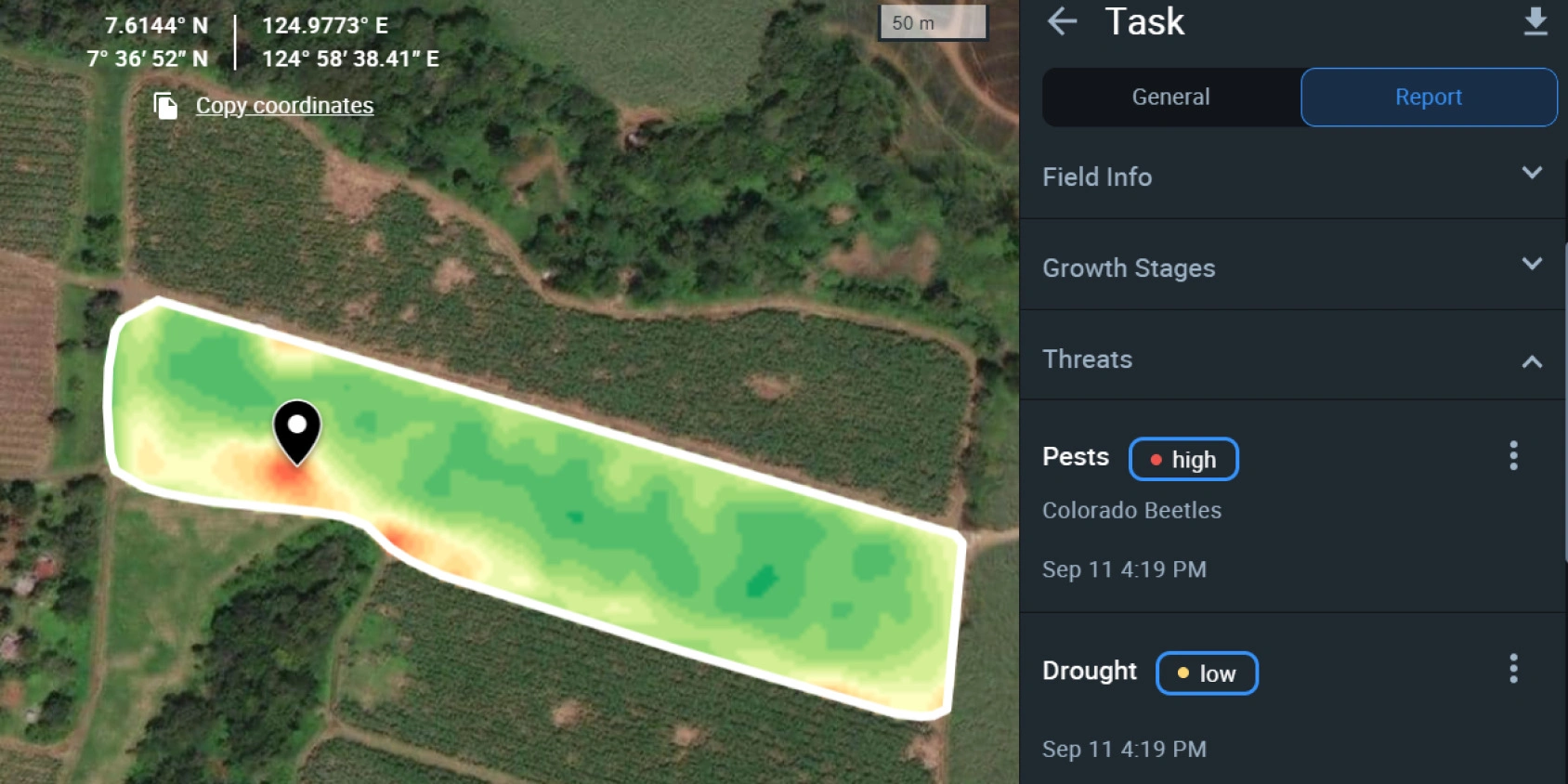
Once you confirm the presence of potato pests, it’s time to take action. Using the Field activity log in EOSDA Crop Monitoring, growers can promptly plan and execute pesticide applications, tailoring the approach to the specific situation in each field. This may involve selecting different products or adjusting application rates based on the severity of the infestation and the growth stages of pests present. Simply inputting the application rate and input price on the platform will give you an instant estimate of the general treatment’s cost.
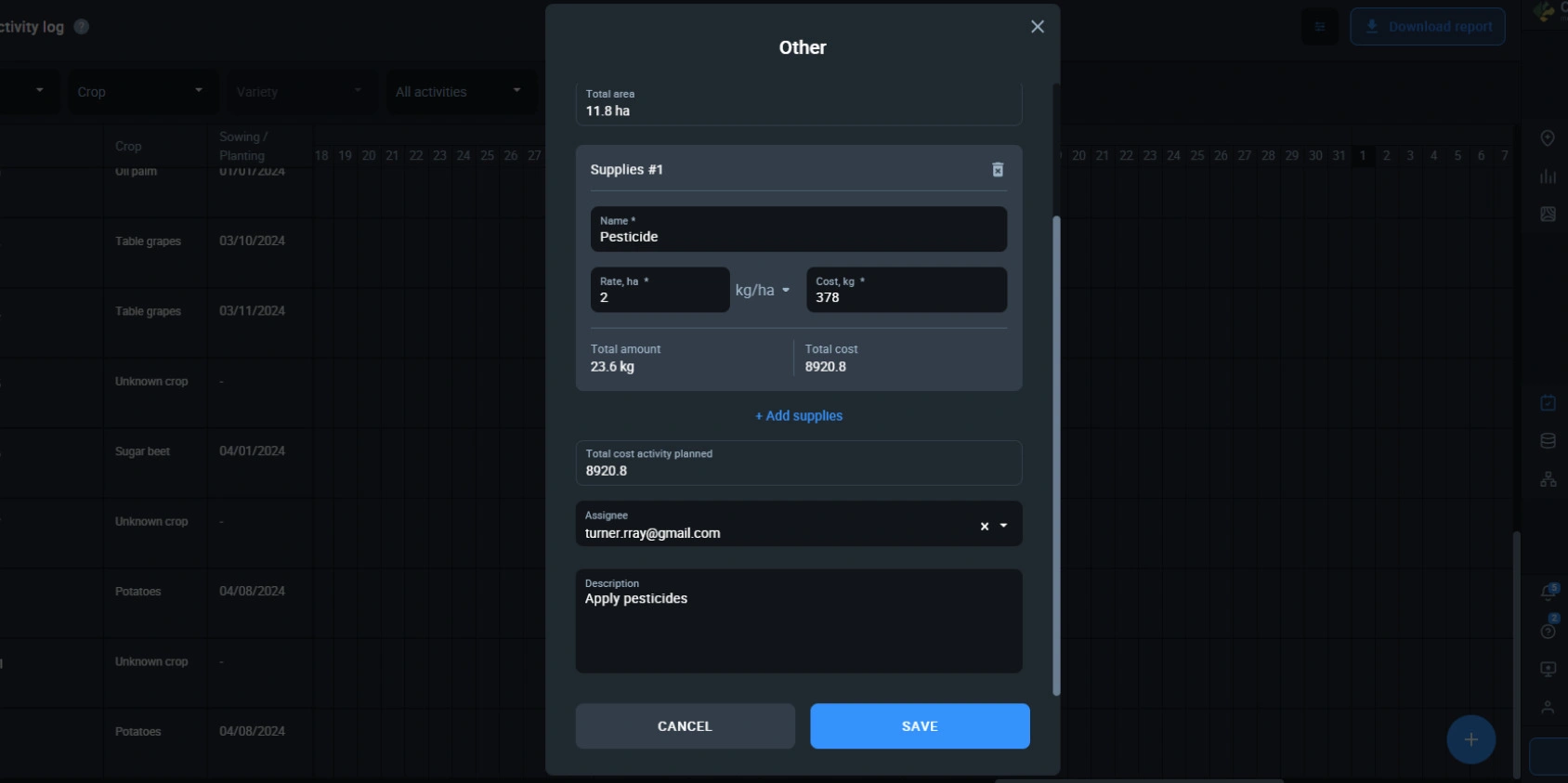
Long-term pest management relies heavily on cultural measures, namely crop rotation. Avoid planting potatoes in fields where potatoes or related crops (Solanaceae) like eggplants and peppers were recently grown, as this can lead to a buildup of beetle populations. Separate the potato field from the field where Solanaceae were grown last season by at least 650 feet (200 m). In EOSDA Crop Monitoring, you can easily track crop history and plan rotations for one or more adjacent fields. Analyzing your field’s crop history can help you optimize crop rotations, anticipate potential pest pressures, and plan insecticide applications (especially if Solanaceae were previously cultivated or are growing nearby).
With our custom Crop type classification solution, you can examine an entire region and find out what crops were grown there. This information gives an edge in selecting crops for planting, considering both exposure to potential pests and diseases, as well as the local market landscape and opportunities for profit growth.
BBCH 50–59: Inflorescence Emergence
When a potato plant is done growing new leaves and reaches its full height, it starts to emerge inflorescences at the top of the stem. During the inflorescence growth stage, potato plants develop their flower buds, which might either abort or grow into full flowers as the season goes on. This is a transition stage when the potato plant shifts from vegetative growth to preparing for reproduction.
Despite being relatively short and not requiring much from the farmer, the inflorescence growth stage of potatoes lays the groundwork for successful flowering and subsequent tuber development. Water demand begins to increase as plants prepare for the flowering stage. We now recommend supporting water supply comparable to earlier vegetative growth stages and avoiding overhead irrigation so as not to damage emerging flower buds.
BBCH 60-69: Flowering
When potato plants blossom, which usually happens 60–70 days after planting, they enter the reproductive growth stage. Blossom growth signals the onset of tuber maturation below ground. However, it’s important to note that some plants may skip flowering, especially in hot climates. During the potato flowering stage, plants require careful nutrient and water management to support aerial plant part growth and underground tuber growth.
Irrigation And Nutrient Management
About 70% of potato roots are concentrated in the top 12 inches (30 cm) of soil. Also, the amount of water and nutrients available to the plant’s roots impacts how many of the initiated tubers will mature. Thus, it is needed to monitor soil moisture in the root zone when potatoes go through the flowering stage. Soil moisture above 65% field capacity promotes a high tuber set, while fluctuating water and nutrient conditions can lead to malformed tubers.
EOSDA Crop Monitoring’s root and surface zone soil moisture help growers plan irrigation effectively. Using them, farmers can monitor field conditions remotely and ensure adequate moisture supply during the flowering growth stage, especially when natural sources are insufficient.
Balanced fertilization is also essential at this potato crop stage, with a concentration of potassium and phosphate to promote tuber growth and quality. Apply nitrogen carefully to avoid excessive vegetative growth at the expense of tuber development. EOSDA Crop Monitoring’s VRA maps can back your fertilizer application at this growth stage.
Disease Management
Many crop diseases, such as Alternaria, late blight, and Fusarium wilt, are more likely to manifest during the flowering stage of potato growth. Environmental conditions like humidity and temperature, along with the quality of seed material, largely influence the development of these diseases during the flowering potato crop growth stage.
EOSDA Crop Monitoring offers a valuable tool for potato growers to manage pathogen threats effectively during this crucial growth stage. The platform’s Disease risk feature monitors 16 different potato diseases, providing real-time risk assessments based on accurate meteorological data and potato growth stage information. In this way, farmers can stay ahead of potential outbreaks and respond quickly.
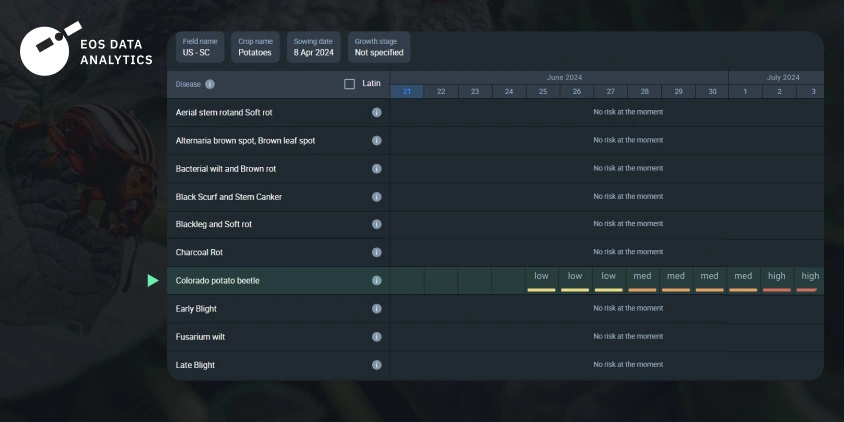
BBCH 70-79: Development Of Fruit
During the fruit development stage, potato plants focus their energy on tuber growth. As nutrients shift towards the developing tubers underground, the foliage starts to lose vigor.
This growth stage is crucial for yield formation, but it also brings increased susceptibility to diseases. Keep using the Disease risk feature in EOSDA Crop Monitoring to prevent the disease growth. Additionally, the Field Activity log aids in planning fungicide applications, ensuring optimal protection for the maturing potatoes. With these features, you can safeguard crop yields and potentially reduce unnecessary treatments during the fruit growth stage.
BBCH 80-89: Ripening Of Fruit And Seed
When the potato crop enters the ripening stage, visible changes occur in the plant’s appearance and physiology. The foliage begins to yellow and wither, signaling the final stage of tuber growth. Farmers should focus on monitoring the state of vegetation during this growth stage to determine the optimal harvest time.
One effective method for tracking crop maturity is observing changes in NDVI values. As the plants progress through the ripening stage, NDVI values decline. For potatoes, an NDVI value between 0.3 and 0.35 typically suggests growth cessation and readiness for harvest. By using this data, growers can efficiently plan their harvesting schedule.
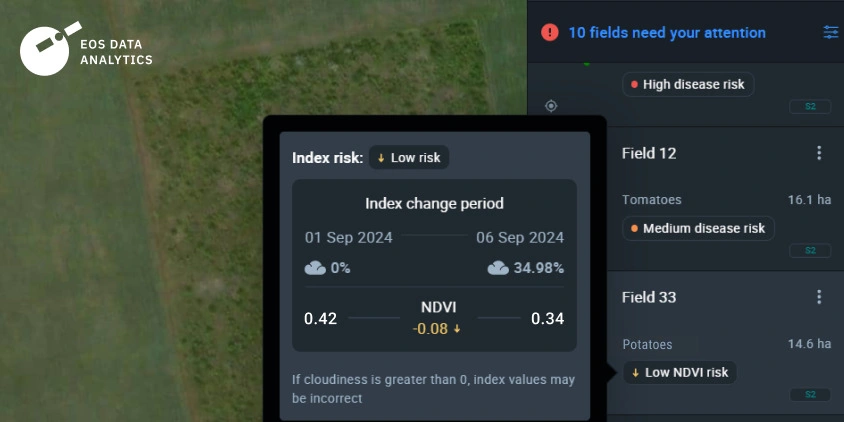
BBCH 90-99: Senescence
The potato plant senescence (aging) stage typically starts 80–100 days after emergence and continues until the vines naturally die back. We recommend reducing water input at this growth stage to prevent tuber rot during storage . Harvest timing is crucial, with ideal temperatures ranging from 45–60°F (7–15°C). Warmer temperatures at this growth stage can lead to tuber bruising and an increased risk of diseases like water rot and pink rot.
Growers should plan harvest days, aiming for cool, dry, and overcast conditions to minimize tuber exposure to sunlight. It’s a no-brainer thanks to Weather forecasts in EOSDA Crop Monitoring that provide hourly field-specific meteorological data (warmth, rain, etc.) for up to 14 days.
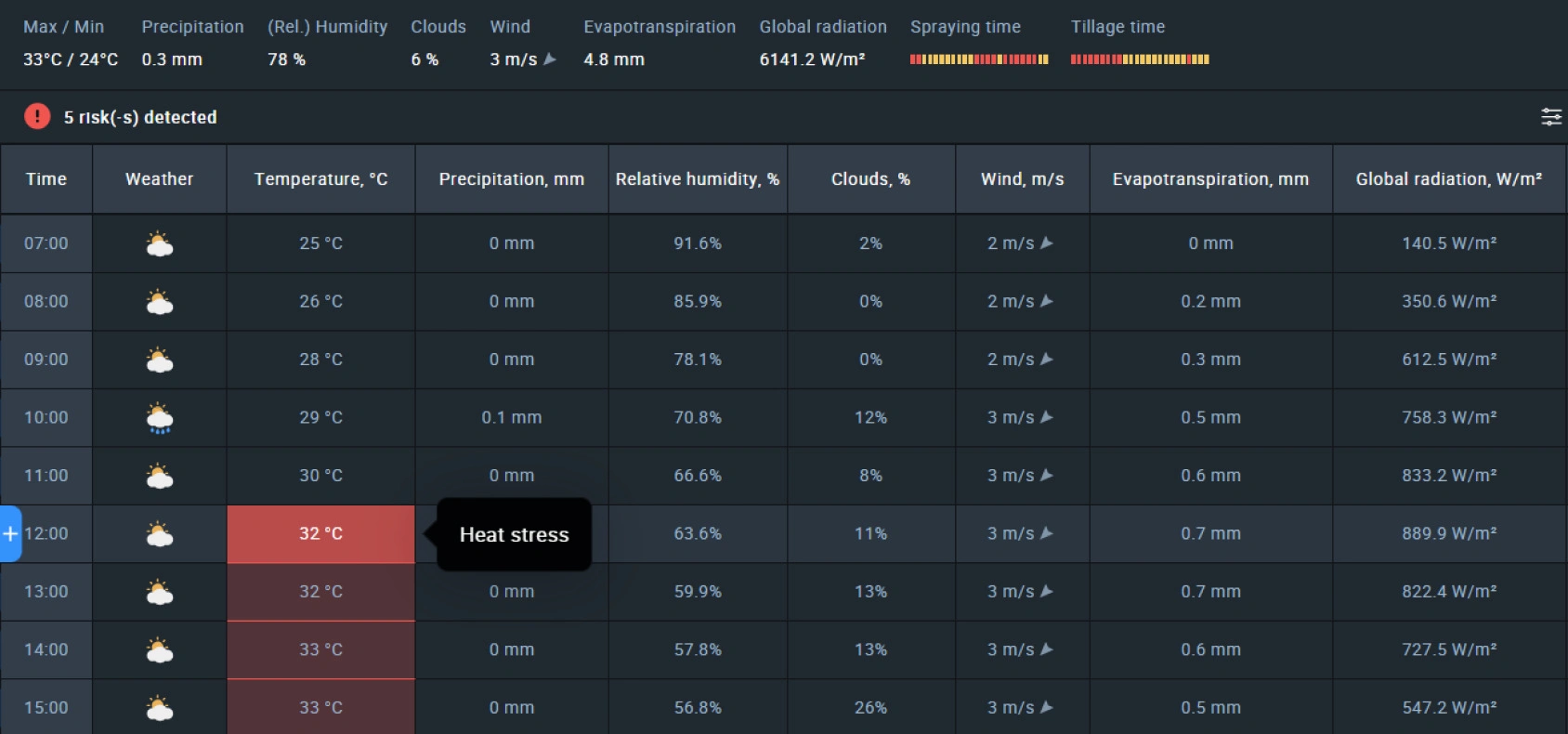
After harvesting, dry the tubers in the shade for 2-3 hours to solidify the skin. Combining this process with harvesting in dry soil conditions enhances storage quality and minimizes the likelihood of rot-causing organisms sticking to the tubers. Remember to remove volunteer potatoes, tubers left in the field after harvest, to prevent disease transmission to future crops.
About the author:
Vasyl Cherlinka is a Doctor of Biosciences specializing in pedology (soil science), with 30 years of experience in the field. He attended the engineering college in Ukraine and received his degree in agrochemistry, agronomy and soil science in the Chernivtsi National University. Since 2018, Dr. Cherlinka has been advising EOSDA on problems in soil science, agronomy, and agrochemistry.